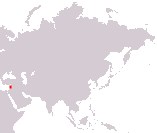
Lebanese Republic
Al Jumhuriyah al Lubnaniyah
Al Jumhuriyah al Lubnaniyah
Government type Parliamentary republic
Area 10,452 kmē (4,036 sq mi)
Population 5,219,000 inh. (2024 est.)
Population density 499 inh/kmē (1,293 inh/miē)
Area 10,452 kmē (4,036 sq mi)
Population 5,219,000 inh. (2024 est.)
Population density 499 inh/kmē (1,293 inh/miē)
Capital Beirut (433,000 pop., 1,970,000 urban aggl.)
Currency Lebanese pound
Human development index 0.706 (112th place)
Languages Arabic (official), French, English
Life expectancy M 78 years, F 82 years
Currency Lebanese pound
Human development index 0.706 (112th place)
Languages Arabic (official), French, English
Life expectancy M 78 years, F 82 years
GEOGRAPHY DATA OF LEBANON
Largest cities
Beirut 433,000 pop., 1,970,000 urban aggl.
Tripoli 229,000 pop.
Sidon 164,000 pop.
Tyre 135,000 pop.
Highest mountains
Qurnat as Sawda' 3,088 m (10,131 ft)
Longest rivers
Orontes 571 km (355 mi), including parts in Syria and Turkey
Litani 145 km (90 mi)
Largest lakes
Qaraoun (artificial) 12 kmē (4.6 sq mi)
ADMINISTRATIVE DIVISIONS OF LEBANON
Lebanon is administratively divided into 7 governorates, with the district of the capital Beirut having equivalent status; Baalbek-Hermel, in the north-eastern part of the territory, is the largest district, while that of Mount Lebanon, which includes many suburbs of the capital, it clearly rank first for the number of inhabitants.The last census dates back to the distant 1970 and there are no uniform data on the population of the cities, but rather estimates made in different years.

